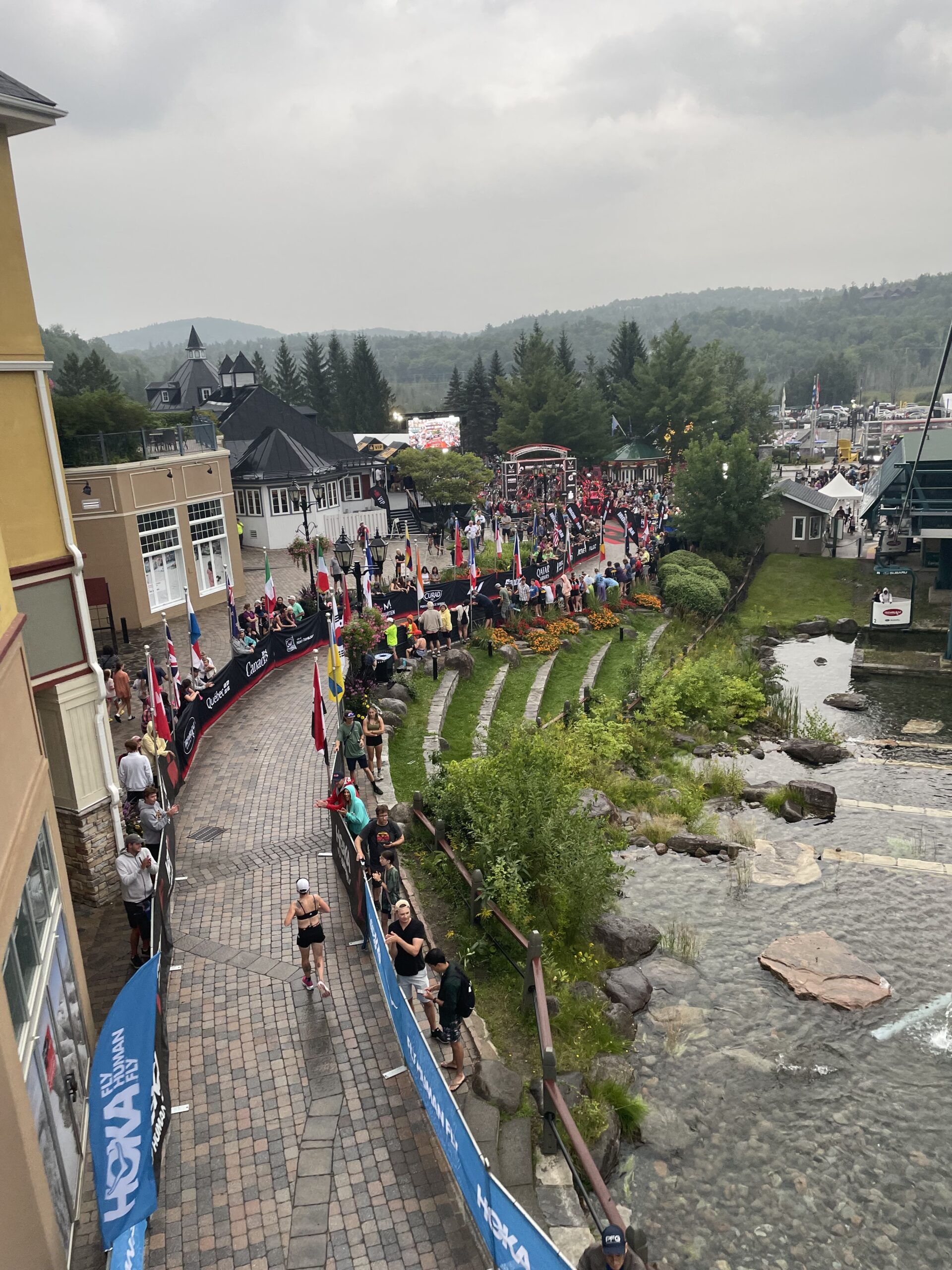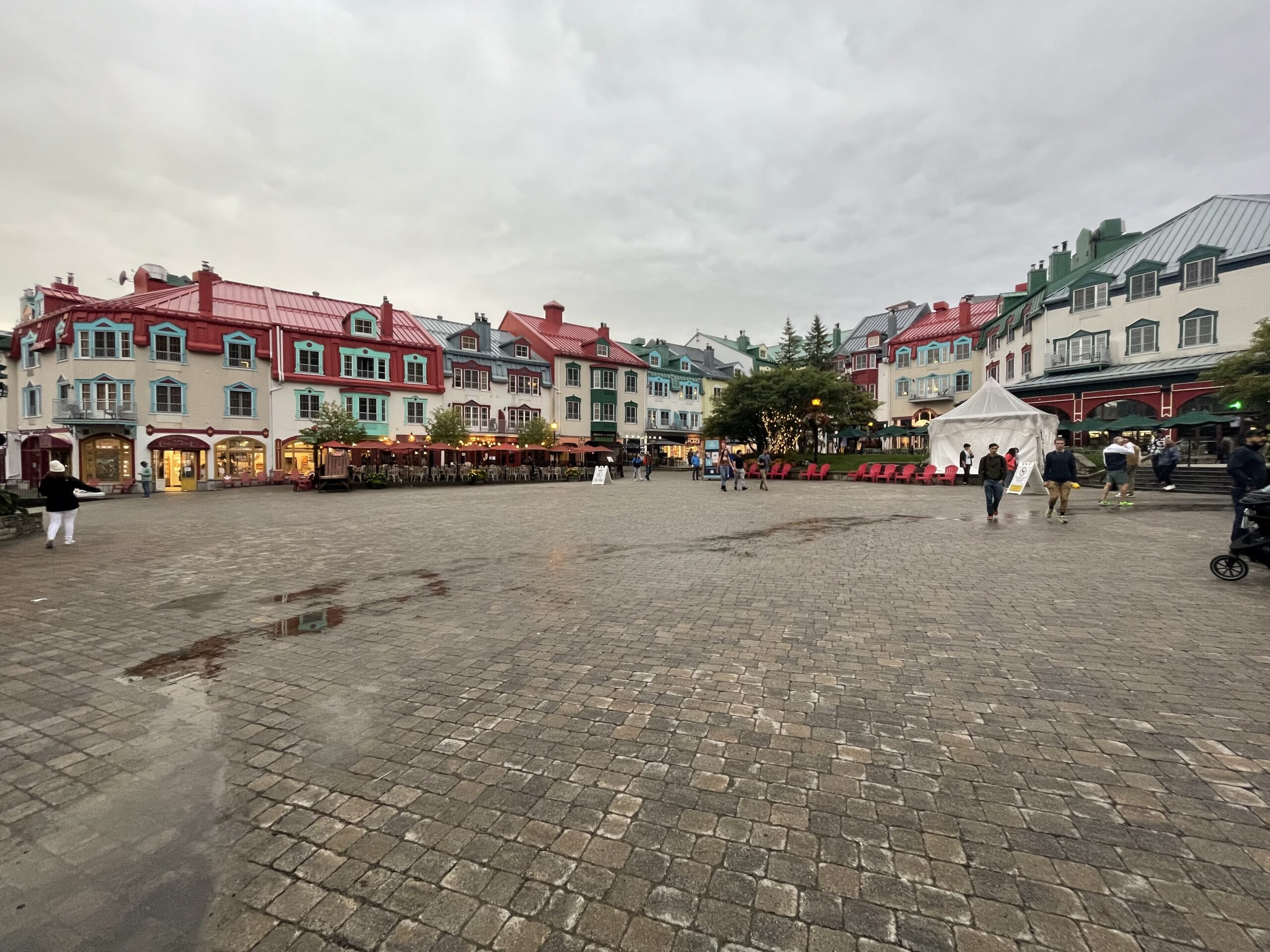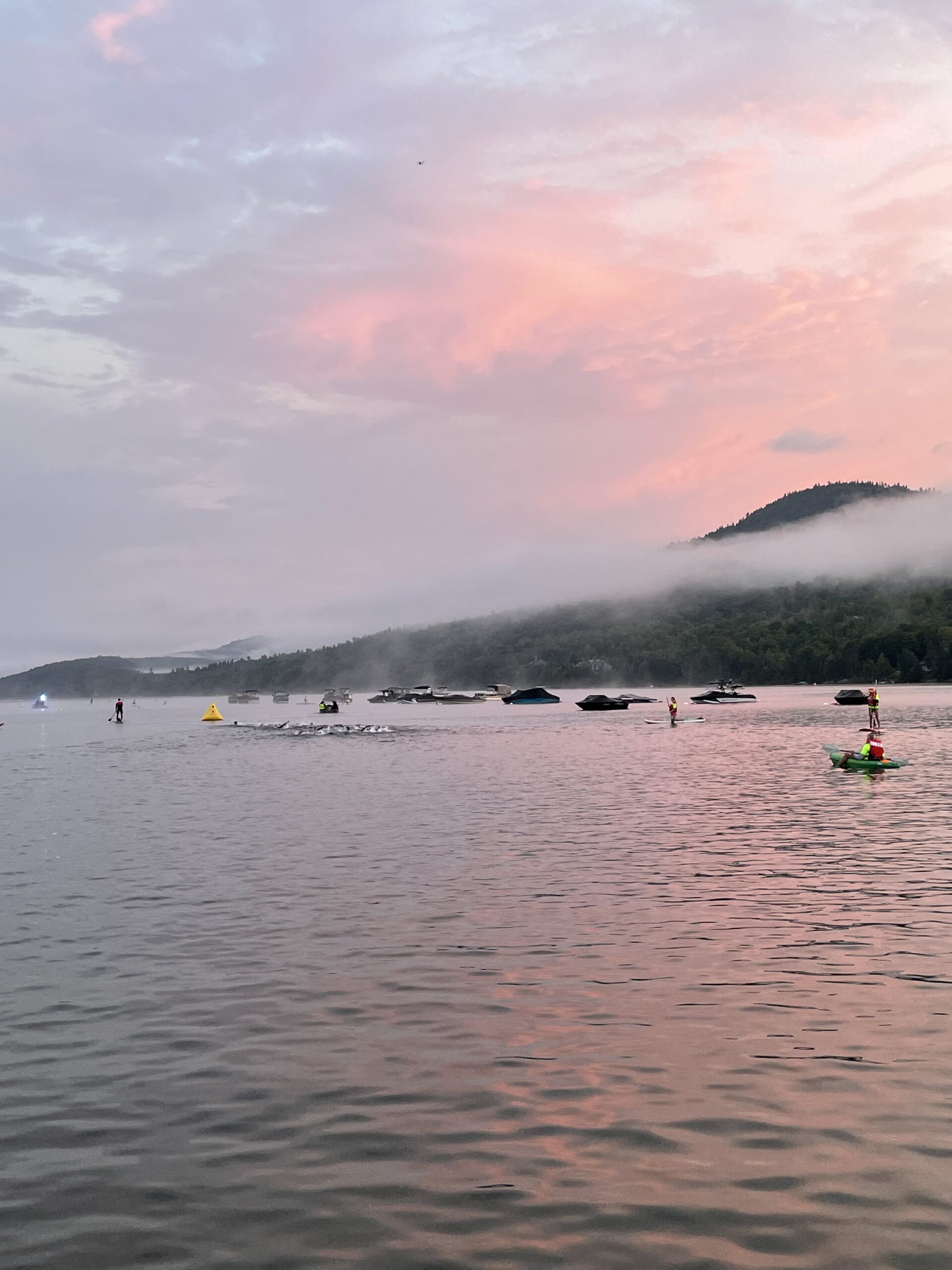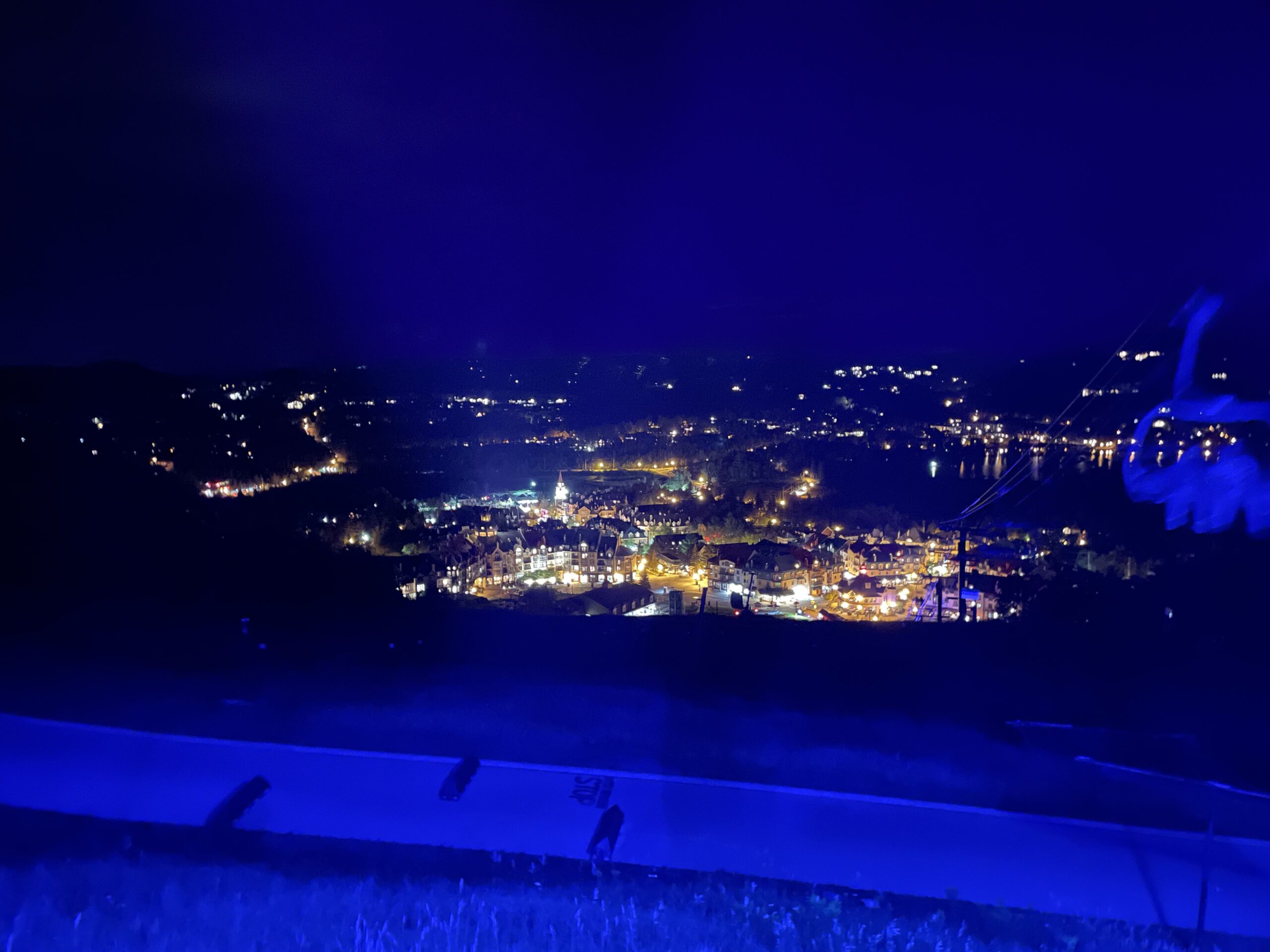Mont-Tremblant Ironman Celebrates Athletes, Environmental Sustainability
Picturesque Quebec village showcases natural resources and individual tenacity in one weekend
Posted On: August 31, 2023 By :
Leaving Montreal’s airport and heading north, what strikes you first is how progressively greener the scenery gets heading out of the city. On a busy Friday afternoon, it takes about two hours to reach the destination. Along the way, every building is a soft pastel with colored roofs straight out of a scrapbook of what you’d expect in a ski village of the Alps, with other lodging carved into the mountains in levels like staircases.
The center square at the top of the first incline of the village is off limit to cars, encouraging walking on the main boulevard, which is filled with restaurants, children’s clothing stores and fitness and outdoor gear shops. Restaurants, packed on this Friday night, offer pasta, seafood and an original take on the most Canadian of dishes — poutine. People who have finished dinner early wait for entry into the chocolatiers and ice cream shops for dessert.
This is Tremblant, a little village tucked into the Quebec mountains. For a first-time visitor, it enchants with a variety of outdoor activities geared toward a family weekend. On this weekend visit, it is home to not one but two Ironman triathlons, both a 70.3 and a full race. The weekend of competition, in this setting, also serves as a reminder of what could be forgotten and what could be endangered without a further focus on environmental sustainability.
Reprieve from ‘a tough summer’
Hop into the enclosed gondola and ride to the top of the mountain over Tremblant as the village drifts gently out of view. Rising into the mist, the landing spot for the gondolas reveals a social hall, food options and a tourist stop. There are also multiple hiking options depending on your level of fitness and interest.
Conditions the day before the races are perfect for the organizers and participants: Cool and rainy, a respite from a summer of heat, fire and distress throughout Canada.
Canadian wildfires this summer have charred more than 30 million acres. Burning twice as much land as any previous season (equivalent to the size of the state of Alabama), Canada’s national wildfire preparedness scale, which measures the need for firefighting resources, has been at Level 5 out of 5 since May 11.
“It’s been a tough summer,” said Pierre-Alexandre Legault, manager of membership, public relations and communications for the Tremblant Resort Association. “We feel like we’re always on the tips of our toes with the weather. (Today) we’re happy that we have this beautiful lake, great weather, no wind. It’s been tough but we feel like it’s not only Tremblant, it’s been everywhere in Canada and the States recently.”
The size of its destruction is approaching the entire area burned during the five seasons from 2018 to 2022 in the United States (38.2 million acres). The visit to Tremblant allows a spectator to watch two Ironmans because the 70.3, scheduled for June, was postponed due to poor air quality; on the same day Tremblant holds its events in clear conditions, a separate Ironman event in British Columbia is cancelled because of the fires.
“Our nature is very important for us,” said Julie Marchildon, marketing manager for Tourisme Mont-Tremblant. “We don’t have big issues right now, but we have to educate (visitors) and make sure they will respect our nature.”
Saturday night, the village is much quieter. And with good reason; the first race starts right at sunrise the next morning. The restaurants are fuller in the early evening; A Mano Trattoria was filled with pasta plates and pizzas on tables, some patrons drinking a glass of wine but most hydrating with water.

Tremblant burst onto the scene in 2012 as a popular triathlon destination thanks to the success of both the Ironman 70.3 and full Ironman. The region hosted the first Ironman 70.3 World Championship to be hosted outside the United States in 2014, ushering in the event’s global rotation.
“It’s like a city that arrives within a city,” Legault said. “It’s very good for the hotels, the restaurants, the shopping and commercial area. Then there’s people going to the municipalities and small towns around.”
The environment is one of anticipation (with a reasonable amount of nerves). Tomorrow’s dual races mark a landmark day for more than one reason — Ironman and Evenements Sportifs Mont-Tremblant have mutually agreed to discontinue the full race although the 70.3 will continue.
The rain mostly moved out of the region and instead the forecast for race day is sun with temperatures hovering in the high 70s during the middle of the day. And most importantly, clear air.
“We are very eco-responsible and Ironman is a very good event for that,” Legalt said. “Having people in these beautiful surroundings, pristine lake, the mountains we have, it helps showcase that we have to take care of these.”
International benefits of sports tourism
The Ironman has brought more than race weekend benefits for Tremblant. One athlete on Saturday at La Diable Microbrasserie, over a poutine lunch, mentioned how his family rented a house on the lake for two weeks to stay for vacation.
“Most of the athletes take more than just one day for the competition,” Marchildon said. “They come before, they stay after, they take time with their family because we know family is involved in the project. They just want to say thanks to their families and enjoy activities and take vacation at the same time.”
Plus there is the year-round visitation for the region thanks to additional facilities and the natural beauty of the area.
“(Ironman) did put Mont-Tremblant on the world map as an international event,” Legault added. “We were very well known as a tourist destination, a family destination, a summer destination. But now athletes come here to train and they bring their families. Even if they don’t race here, they train here.”
“We see more people do sports and are more active than before,” Marchildon added. “I’m sure the culture will stay here because it’s in our community, people are involved in the event.”

And now … the event. The full Ironman starts first with the professional female competition, followed by the other competitors. The race starts at Lac Tremblant, competitors racing into the water as the sunrise begins to paint the sky shades of pink with hundreds of fans gathered on the sandy shores. Competitors for both races — full and 70.3 — exit the lake at a different spot closer to the village, stripping off watersuits while scattering up the red carpet toward the transition area at the base of the village.
Along with all the encouragement of fans and family, the next noise is the click and clack of cycling shoes running out of the transition area before athletes hop on bikes and head out of the village. The road out includes multiple tree-lined uphill climbs from the village before heading onto the Canadian Interstate Highway nearby a McDonald’s and Tim Horton’s.
The bike route goes on seemingly forever, with several water breaks thanks to supporters shouting encouragement at each spot. There are hockey nets to throw empty bottles into instead of littering the highway. The turnaround to go back is quick and short, a 90-degree turn with cones heading back into town — which still takes a while, given the Ironman races are meant to test every fiber of resolve in a person’s body.
Back into the village after the ride, the run begins. Those heading back out of the heart of the village take a trek that goes two laps for those in the full Ironman. Ahead of the finish, the village running path cuts right into the center of town with a right turn onto the bricks and a straight downhill path through the finish line with fans cheering on both sides with cowbells and voices.
“Three weeks before the event, I was very nervous,” said Race Director Pauline Alix, who started as a volunteer at the first Ironman Mont-Tremblant in 2012 and was in charge of the event for the first time this year. “But on Monday when every member of the team arrives, I’m not nervous anymore because I know they’re going to do what they do best to make this event possible. … This has been a special one. We don’t see (two races) often and for my first year, it’s been challenging but also a big learning experience.”
As the hours go on, people continue to come into the village, from the first finishers in the mid-afternoon to those who come in under the cover of night. After crossing the line to complete the race, all finishers are quickly handed a large bottle of water, a medal signifying their accomplishment and a few short steps away is a spot to immediately refuel with pasta (and poutine, because of course). Those who have finished their personal trek are still around into the evening, making sure their bikes are out of the transition areas, then slowly making their way back up the hill and grabbing something additional to eat.
This visit ends on Monday morning as you leave across the little bridge, the village in your rear-view mirror to bring a smile from the experience of having set foot in Tremblant. One memory from your Friday night arrival lingers; it’s from taking the sky lift up to see the experience of Tonga Lumina, a light show set up throughout the forest with mottos about the wildlife and life itself. One of them, midway through the trek, resonates particularly having been able to enjoy the hospitality of the village, the surrounding environment and the emphasis on sustainable sport in an overheated summer: “Observe, Love, Protect.”
